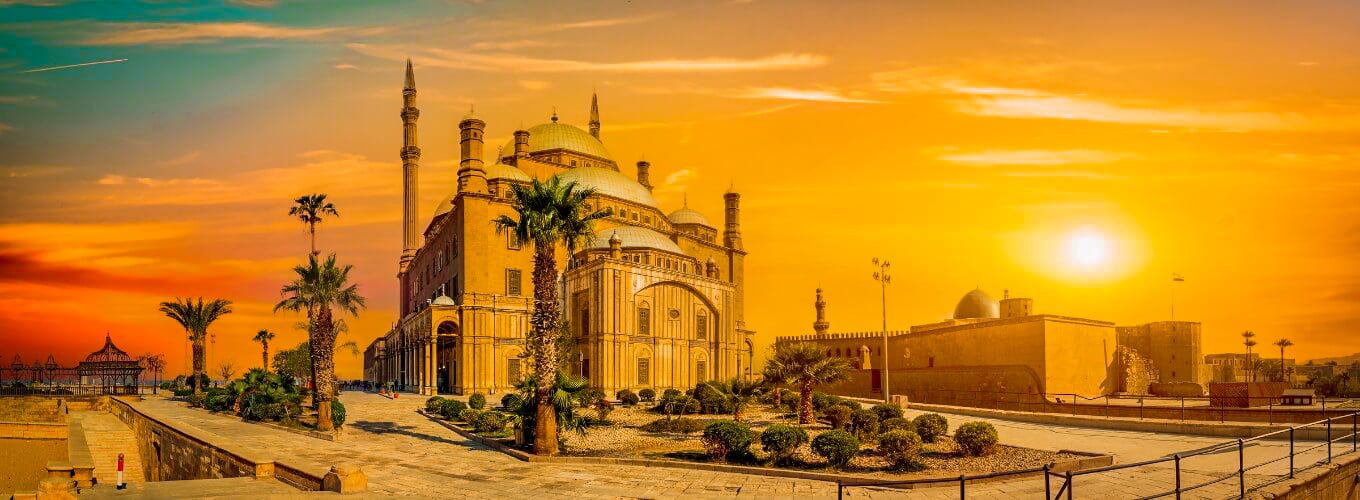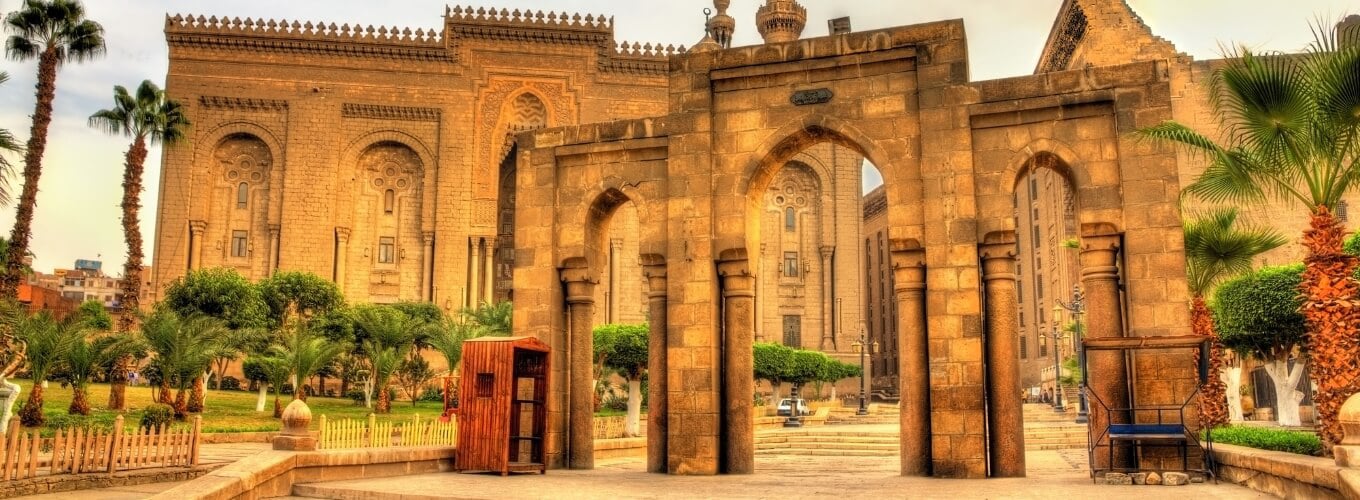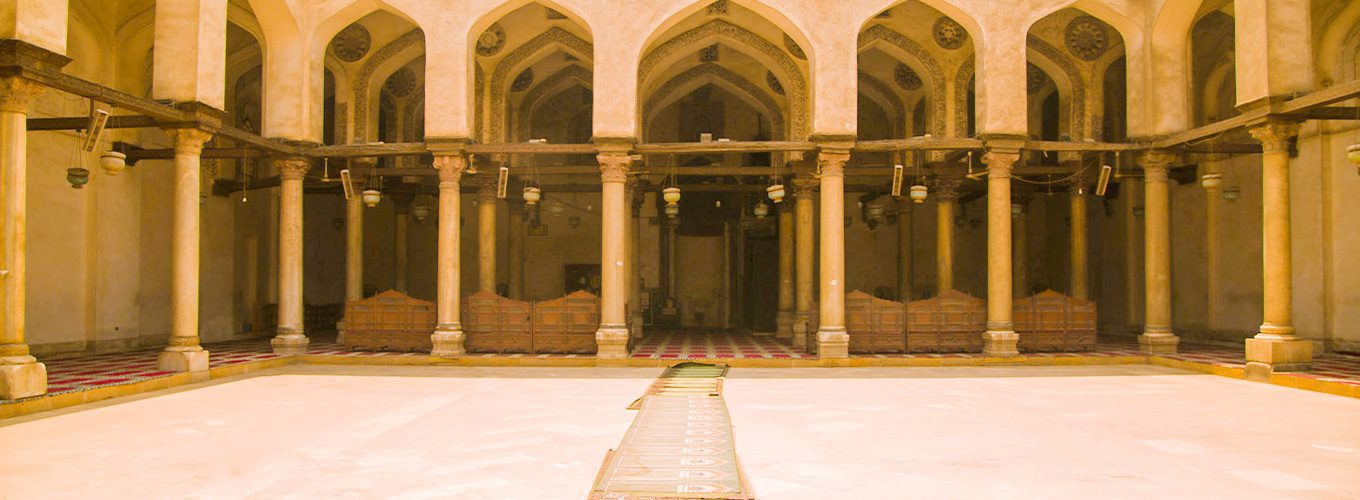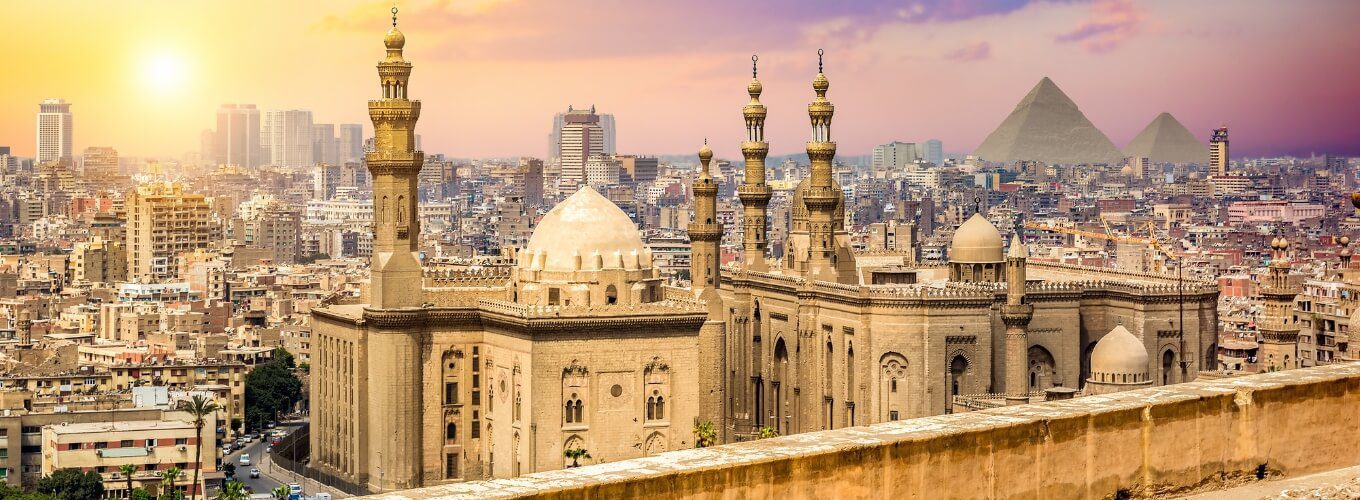Cairo is Egypt’s bustling capital, full of Islamic architecture and history. The city’s mosques are not just for worship. They are also architectural wonders that amaze everyone. Are there any hidden gems that show Cairo’s true Islamic heritage?
This guide will take you to some of Cairo’s most famous and stunning mosques. You’ll see their unique features and learn about their history. Whether you love history, architecture, or just want to see the city’s spiritual side, you’ll find something interesting in Cairo’s mosques.
Key Takeaways
- Discover the most iconic and historically significant mosques in Cairo, from the Alabaster Mosque to the Al-Azhar Mosque.
- Explore the architectural wonders that set these mosques apart, including towering minarets, intricate interiors, and unique design elements.
- Uncover the fascinating historical context and cultural significance of each mosque, providing a deeper understanding of Cairo’s rich Islamic heritage.
- Learn practical tips for visiting these mosques, including dress code, etiquette, and the best times to explore these architectural masterpieces.
- Gain insights into the top Cairo mosque tours offered by reputable tour operators, ensuring you make the most of your visit to these sacred sites.
You can benefit from our discounted offers through the following All Inclusive Vacations to Egypt:
- 7-Day Cairo with Nile Cruise Tour Package Get -100 USD
- 8 Days Cairo with 3 Nights Nile Cruise by Flight Get 10% Off + Free Activities
- 8 Days Cairo and Nile Cruise Holidays with Abu Simbel Get 7% OFF
- 10-Day Cairo, Alexandria, and Nile Cruise with Abu Simbel by Flight Get 10% OFF
- 12 Day Cairo City & Nile Cruise and Hurghada City
1- Al Azhar Mosque
Al-Azhar is the great ancient Egyptian Mosque in Islamic history. It was constructed between 359 and 361 AH, 970 and 972 AD. Over a thousand years ago, it was simultaneously a mosque and a school.
When Jawhar al-Aqili, commander of the army of the Mu’aazilldin Allah, the first Fatimid caliph of Egypt, assumed control of the country, it was formed to spread the Shi’a faith. The Sunni school of thought is currently used to teach Islam in Al-Azhar.
After building the city of Cairo, Al-Aqli started and completed the construction of the Al-Azhar. It was used for the first Friday prayer on the 7th of Ramadan, 361 AH / 972 AD. It is the oldest Fatimid building in Egypt, and the first Mosque established in Cairo.
Historians differ on the origin of the name of this Mosque. It is more likely that the Fatimids named it Al-Azhar after Fatimah al-Zahra, daughter of the Prophet Muhammad (may God bless him and grant him peace) because they loved her and wanted to be remembered for how much they thought of her.
2- The Mosque of Ibn Tulun
The Mosque of Ibn Tulun was started by Ahmad Ibn Tulun, the Abbasid governor of Egypt from 854 to 270 AH (868 to 884 AD), and ruled Egypt as an independent state from 266 AH (872 AD).
The building work started in 263 AH/876 AD and was done in 265 AH/879 AD. It was meant to be the principal place of worship for Ibn Tulun’s new administrative capital, al-Qat’i.
It was built on Jebal Yashkur, Ahmad Ibn Tulun Square, Sayyida Zaynab. Building this Mosque was another way for Ahmad Ibn Tulun to show that he was not part of the Abbasid Caliphate.
In the middle of the square is a water fountain with a dome on top held by marble columns. Indoors, there are six mihrabs. The mihrab is a hole in the wall that shows the direction of the Kaaba in Mecca, which is the order Muslims face when they pray. The main mihrab is hollow and has a lot of beautiful designs on it.
3- Mosque of Muhammad Ali

The Mosque of Muhammad Ali is One of Cairo’s most well-known archaeological mosques. It was built in the Ottoman style by Muhammad Ali Pasha. It is sometimes called the Al-Marmar mosque or the Al-Alabaster mosque because it has many of these types of marble on its walls.
The Nasser al-Qalawun Mosque was built inside the Citadel of Saladin. Several other mosques, including the Sultan Hassan Mosque, the Rifai Mosque, and others in Islamic Cairo, are outside and near the castle wall.
It has a square prayer hall with a dome on four rafts and semi-domes on all four sides. The crown covers the mihrab, which sticks out from the wall.
Four small domes were put on the corners, and two thin minarets, each 84 meters long and based on the ones in Turkey, were built on the wall facing the mihrab. West of the Mosque is a court with a place to clean your hands and feet. On the western edge is the clock’s tower, a French King Louis Philippe gift. From this court, you can see the city of Cairo, the Nile River, and the pyramids.
4- Al-Hakim Mosque
Al-Hakim Mosque is one of the ancient mosques in Cairo and the second central Fatimid Mosque in Egypt. The Mosque was finished when AI Hakim’s son was in charge, so it was named after him.
5- Amr ibn Al-As Mosque
This is Al Fustat’s first and oldest Mosque. In the Hijra year 21, when Amr built it, the ceiling was made of palm leaves, and the pillars were made of palm stumps. In the year 1211 of the Hijra calendar, Prince Muhammad Bey ordered to tear it down and build it again. The Mosque’s new design was very different from how it looked before, and not much of its old look has been kept.
6- Sultan Hassan Mosque
Sultan Hassan Mosque is One of Cairo’s most well-known archaeological mosques. It has been called the “Jewel of Islamic architecture in the East” and the best example of how Cairo’s Islamic architecture is consistent and works well together.
It is at the end of Al Qalaa Street, where it meets Saladin Square. Muhammad ibn Qalawoon gave the order to build the Mosque and turn it into a school of religion. People think the Mosque is one of the best Islamic buildings in Egypt. The middle of the Mosque’s four schools is an open court with four booths.
7- Al Rifai Mosque

One of the important mosques from the past in Cairo. The last king of Egypt, King Farouk, and many other royal family members live near this Mosque. In 1980, this Mosque was where the previous Shah of Iran was buried.
The Al Rifai mosque is an old Fatimid mosque in Cairo, and it is in the Midan Al-Qalaa neighborhood and has two rows of pillars on a 1767-meter square. There are three entrances to the Mosque.
In the middle are a long neck with windows and a giant dome. In the middle of the eastern wall is a large recess that shows the direction of prayer. It is surrounded by two white and one dark green marble pillar. Inside the holiday, or mihrab, are marble mosaics and shells that were carefully cut. Arabic calligraphy is written on the very top of the mihrab.
8- Sayyidina al Hussein Mosque Cairo
One of Egypt’s most well-known holy mosques. It is in the Al Hussein neighborhood in the old part of Cairo, and the famous Khan El Khalili is next to the Mosque.
Over time, the Mosque has been fixed up. When Sultan Abdul Aziz went to Egypt and saw the AI Hussein mosque, he told Khedive Ismail to fix it as best he could.
Marble columns came from Constantinople, and a gold-covered wooden pulpit was made for the Mosque. It had a wooden ceiling with shapes and colors of plants and geometric shapes carved into it. Brass windows covered in gold cover thirty of the Mosque’s walls.
9- Al-Nasir Muhammad Mosque
The Mosque of Sultan alNasir Muhammad ibn Qalawun, in the Citadel of Salah al-Din al-Ayyubi (Saladin) in Cairo, was the royal Mosque during the Mamluk Period.
It is located in the Citadel’s southern section. The Mamluk sultan, al-Nasir Muhammad, ordered this Mosque to be built in 718 AH/ 1318 AD, and he rebuilt it in 735 AH/1335 AD. This Mosque was highly cherished by subsequent Mamluk sultans and used by the Mamluk occupants of the CCitadel.
The Mosque is among the most prominent monuments within the Citadel; the Citadel of an open court surrounded by four porticos. The Mosque has two minarets; the tops of the two minarets and dome were once covered in green tiles and are influenced by an Eastern Islamic style.
The inside of the crown is decorated with a banner of Qur’anic verses, the titles of Sultan al-Nasir Muhammad, and the date of rebuilding the Mosque. The ceiling of the Mosque is decorated with beautiful geometric shapes. The ornate minbar (pulpit) is made of wood, inlaid with ivory and mother-of-pearl, and inscribed with the name of King Farouk.
10- The Mosque for Sultan Baybars
The Mosque for Sultan Baybars, the Atabeg Faris al-Din Aqtai, was built by the vizier and me, Baha’ al-Din ‘Ali ibn Hinna (1269–1271).
It was the first congregational Mosque built in Cairo after the Shafi monopoly on the law was broken. Before that, only one congregational Mosque could be used for Friday prayer.
It is a hypostyle mosque with arcades arranged in a way. In front of the mihrab is a nine-bay iwan qibla or maqsura, surrounded by piers holding a wooden dome.
The central part of the sanctuary, which is made up of an elevated triple aisle and the maqsura, is surrounded by corridors made of arcades on columns that run parallel to the wall facing the direction of prayer (Qibla).
Piers surround the courtyard with pointed arches that hold up the dome of the maqsura. The front portal, which faces the sanctuary, is more extensive and has more decorations than the two side portals.
11- Al-Salih Tala’i Mosque

Saleh Bin Rizk built it in the year 555 Ah. It is considered the last Mosque built in Egypt during the Fatimid era. It looks different from most other Fatimid mosques because it has unique architectural features that aren’t found in many others.
It is in Bab Zuwayla Square in the Darb al-Ahmar district. It faces Bab Zuwayla, one of the gates of the southern wall of the Fatimid City of Cairo.
At first, it was meant to be a shrine for the head of al-Husayn. When the Crusaders were about to attack, the vizier brought the head of al-Husayn from its shrine in Ascalon to Cairo. But the caliph put the relic in a shrine in the Fatimid palace. When the castle was destroyed, the shrine became part of the Mosque of al-Husayn.
12- Al-Moayad Sheikh Mosque
It is located next to Bab Zuweila on Al-Muizz Street. In the year 818 AH / 1415 AD, it was established by Sultan Al-Moayyed Al-Sheikh.
In the middle is an open courtyard surrounded by four entrances. The most prominent entrance faces the Qibla. Marble covers the walls, and ivory and mother-of-pearl are used to decorate the wooden pulpit. On it were written the names and titles of the Sultan al-Mu’ayyad.
It has stood out because of the way it was built. Its two minarets are built over a Fatimid-era building called Bab Zuweila, next to the Mosque. Together, they made an impressive piece of architecture. The name of the founder of the Mosque is written on the western minaret, and on the other is the name of the minaret architect.
It contains many beautiful old things, including a large door with the name of Sultan Hassan on it. Sultan al-Muayyad transferred this entrance from the Madrasa of Sultan Hassan to this Mosque, one of the most beautiful brass paneled wood doors.
13- Sultan Al Mansur Qalawun Mosque
In the 1280s, al-Mansour Seif al-Din Qalawun built it in less than two years. This group of buildings is the first of a new type of building that served more than one purpose. This comprises a tomb, a mosque, and a hospital (maristan). It is on the old Fatimid western palace site, Cairo’s main street in the Middle Ages.
The primary side of the building that faces the street is 67 m long and 20 m high. A large arch made of stone and held up by marble pillars is broken up by bays decorated with geometric interlacing. The sponsor’s name, title, and date of construction are written on a banner that runs the whole length.
Al-Muizz Li-Din Allah Boulevard is where the main entrance to this beautiful complex. The two sides of the door are made of copper plates with beautiful designs cut into them. This doorway leads to a long hallway between the mausoleum mosque and the madrasa.
Amir Alam al-Din al-Shuja’i oversaw construction because he knew much about architecture and engineering. He got the workers together to finish the building faster and told them they couldn’t work elsewhere.
14- Mosque of Amir Al-Maridani
This 14th-century Mosque is in the Darb El-Ahmar neighborhood. Its design combines Islamic, Christian, Ottoman, and Roman styles. Don’t miss the beautiful mashrabiya screens (latticework that keeps out the sun), wooden ceilings, and stained glass windows. Gather your thoughts in the courtyard while you listen to the birds chirping. Even though you’re in the middle of Cairo, you’ll feel like you’re a million miles away.
Egypt Planners: Top Cairo Mosque Tours
Travelers wanting to dive into Cairo’s Islamic heritage can join Egypt Planners’ tours. These tours take you to the city’s stunning mosques. You’ll learn about their history, architecture, and cultural importance.
You’ll also get to explore the lively Cairo neighborhoods around the mosques. This lets you feel the city’s vibrant life.
With Egypt Planners, you’re in for a smooth and deep dive into Cairo’s mosques. You’ll see the Mosque of Muhammad Ali and the Amr Ibn Al-As Mosque. These places tell the story of Cairo’s Islamic past.
|
Tour Highlight |
Key Features |
|
Mosque of Muhammad Ali |
|
|
Amr Ibn Al-As Mosque |
|
|
Al-Azhar Mosque |
|
Joining Egypt Planners tours lets you deeply appreciate Cairo’s mosques. You’ll see the Mamluk architecture and hear the stories behind the mosques. These tours are perfect for those wanting to explore Islamic Cairo.
Conclusion
Cairo’s mosques are symbols of the Islamic religion, amazing architecture, and a deep cultural legacy. They range from the big Al-Azhar Mosque to the beautiful Sultan Hassan Mosque. Each one shows the skill and hard work of its creators. They draw visitors with their beauty and unique features.
Visiting these places lets you dive into Cairo’s spiritual and historical heritage. You can feel the calm and be amazed by the design. These mosques are key parts of Cairo’s look and feel. They invite travelers to see the beauty and depth of Cairo’s Islamic heritage.
Looking at the mosques in Cairo shows you the city’s rich religious landmarks and Islamic architecture. You’ll see tall minarets and beautiful domes. Each mosque shows the hard work and skill of the people who made them.
By visiting these places, you’ll understand more about Cairo’s mosques and its religious landscape. You’ll leave with a new respect for the city’s Islamic heritage.
Make sure to see these amazing mosques when you visit Cairo. Enjoy the special feel, the amazing design, and the stories that have shaped the city’s Islamic heritage for years. This is your chance to see these timeless places and feel the heart of Cairo’s religious landmarks
FAQ – Frequently Asked Questions
Can you enter mosques in Cairo?
About 90% of Egypt’s mosques are places of worship for Muslims and can’t be visited while people pray. At other times, you might only be able to see Sayyida Zeinab Mosque and Al-Hussein Mosque in Cairo.
How many mosques are there in Cairo?
Cairo is known as the “City of 1,000 Mosques”.
Which Mosque is famous in Cairo?
Mosque of Ibn Tulun. It is the oldest in Egypt and all of Africa and is still in its original form.
Why is Cairo important to Islam?
Islamic Cairo is not more or less Islamic than the rest of the city, but it is the area with the biggest and most famous Islamic monuments. Many of these were built by the Fatimid caliphs, who made Cairo (preceded by Fustat or Old Cairo).
What is a Mosque?
It is a place of worship for Muslims. The word “mosque” comes from the Arabic word “masjid,” which means “place of prostration.” Mosque buildings are usually fancy and often used for prayer, Ramadan vigils, weddings, funerals, Sufi ceremonies, business deals, and collecting and giving alms. Mosques are often used as places for homeless people to stay.
Even though it’s not required, most ancient mosques have an imam who leads prayers. They must be free, honest people with much knowledge about religion. Muslims have to wash before they pray, which is called wudu. Also, there are rules about what Muslims and people who are not Muslims can and cannot wear when they go to a Mosque.
Related Articles

